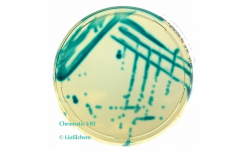Independent third-party testing consistently confirms that routine cleaning alone is not enough to maintain truly clean environments, especially in healthcare settings. As a result, decision-makers in the healthcare industry are seeking building products, materials and equipment that support keeping surfaces cleaner for longer periods of time, and in between routine cleanings.
Long recognized in the development of customized antimicrobial and odor control solutions, the research and development team at Microban International has released a white paper focusing on key benefits of antimicrobial product protection utilized in the healthcare environment. The findings outlined in the paper also highlight 10 key points of consideration for decision makers in the healthcare industry.
Dr. Gina Sloan, Director of Innovations at Microban authored the paper.
“Embedded antimicrobials are antimicrobials that are incorporated into products during manufacturing, and hence become a permanent part of the product. The role of embedded antimicrobials as part of an overall 'systems approach' to creating cleaner surfaces in the healthcare environment is an important topic to examine. The goal of this white paper is to provide interested parties a basic understanding of embedded antimicrobials, an overview of the benefits of such antimicrobial solutions and address common misconceptions about the use of these antimicrobials.”
Embedded antimicrobial technologies are used in a wide variety of healthcare-related products, including storage and transport equipment, building materials, procedural tools, and administrative supplies and equipment. The incorporation of built-in antimicrobials complements good hygiene practices by providing an added level of protection, keeping products and equipment cleaner between cleanings, at a microscopic level.
One important takeaway from the white paper is a summary of key points that should be considered when evaluating the presence or use of embedded antimicrobials in products, equipment and other materials that will be used in the healthcare environment, such as:
The patient environment can harbor pathogens. A prior patient having an infection can increase the risk of a new patient getting a HAI (Hospital Acquired Infection) even after the room is cleaned after the prior patient has been vacated. Studies have shown increased risk of up to 1.4X for a Methicillin Resistant Staphylococcus aureus (MRSA) infection, 2.5X for a Vancomycin Resistant Enterococcus (VRE) infection and 2.5X increased risk for a Clostridium difficile infection.
Hand washing isn’t sufficient. Despite over 7 years of increasing hand hygiene awareness and use of rigorous monitoring programs, there is still only a 40% compliance rate among healthcare workers. This means that 6 out of 10 times there is a missed opportunity for a healthcare worker to appropriately wash their hands, leading to cross contamination and increased risk of HAIs.
There are different types of antimicrobials that are often mistakenly interchanged. Antimicrobial is a broad term that actually encompasses three classes. The three classes of antimicrobials are:
Antibiotics: utilized for treating patients with microbial based infections. Disinfection antimicrobials: antimicrobials utilized in liquid or wipe applications that deliver high kill rates quickly but provides discontinuous microbial reduction. Embedded antimicrobials: antimicrobials utilized for product preservation, odor control, control of stain causing microorganisms, or continuous microbial reduction on a material. These are frequently chosen for their chemical and temperature stability and can be incorporated into products when they are being manufactured.
A systems approach is needed in healthcare. There are multiple avenues that can lead to a reduction in HAI rates. These include adherence to strict handwashing regimens and rigorous monitoring and accountability programs, vigilance over patient care, and care of the patient environment. Only by impacting all three areas of the healthcare ecosystem will a significant reduction in HAI rates be obtained.
Embedded antimicrobials are safe for the environment. Embedded antimicrobials are securely incorporated within the article and do not leach out into the environment.
Embedded antimicrobials are safe for people. Embedded antimicrobials go through rigorous safety testing in ordered to be registered with the United States Environmental Protection Agency (EPA). These tests evaluate the impact of the antimicrobial on human health and safety.
Embedded antimicrobials have proven efficacy. There are multiple government and not for profit institutions that develop protocols to demonstrate antimicrobial efficacy. Microban adheres to a strict internal standard demanding that at a minimum each product must demonstrate a 90% reduction in bacteria over the use of the article.
Embedded antimicrobials are durable. In addition to efficacy testing, Microban performs durability testing that is specific to each end product. This includes UV exposure, washing, cutting, scuffing, and simulated end use conditions for each polymer type and application.
Embedded antimicrobials provide a cleaner between cleanings solution. Studies indicate that bioburden on a hospital surface can rebound 2 hours after the surfaces has been disinfected. It is not feasible to clean a hospital room every 2 hours and therefore an alternate solution is needed. It is the rapid regrowth of the bacterial population on critical high-touch surfaces that can be cause for concern. Embedded antimicrobials offer a means to reduce the microbial load on a surface over time. These technologies are not meant to replace typical cleaning and disinfection measures but rather they complement good disinfection and cleaning protocols on the patient environment. Embedded antimicrobials allow for surfaces that have reduced microbial burden on the surface between each cleaning.
Embedded antimicrobials do not lead to “super bugs”. Embedded antimicrobials are utilized at levels that do not lead to the development of bacterial resistance. In addition, unlike antibiotics, embedded antimicrobials target multiple areas of the cell. This multi-targeted approach makes it extremely difficult for bacteria to develop resistance. In general, “super bugs” are generated due to misuse of antibiotics by physicians and patients not by the use of embedded antimicrobials.
The full text of the white paper “Antimicrobials in Healthcare” and a complete list of references for the key points can be found at www.microban.com/micro-prevention/white-papers/antimicrobials-in-healthcare.


















